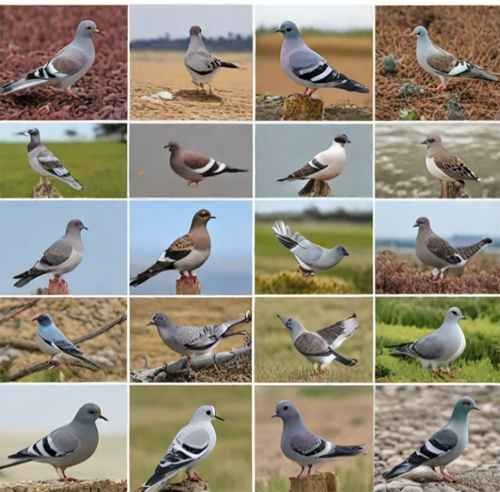Rock doves, are birds well-suited to living around humans. They can survive in various city spots, which makes them common worldwide. Some see them as city pests, yet discovering where they naturally live offers good clues about their ecological habits and actions.
Geographic Origin
They are native to:
- Europe
- North Africa
- Southwestern Asia
- Now, they’ve adjusted to life in urban areas all over the world.

Where Do Rock Doves Call Home? A Look at Their Diverse Habitats
They are our well-known airborne neighbors, showcase an unexpected level of flexibility in seeking homes. Despite seeming at home in busy urban settings, their tale goes beyond this environment.
Wild at Heart: Rocky Cliffs and Open Spaces
Before we saw them walking our city streets, rock doves were masters in natural habitats with unique elements:
- Rocky Coastlines: These steep cliffs right by the sea were perfect for building nests. Small nooks and high spots protected them when they were raising kids.
- Proximity to Food Sources: Wide-open spaces like farmlands or shrubs ensured regular access to seeds and grains, key for their diet.
Thriving in the Urban Jungle
People unknowingly created a paradise for these birds. This is why they find cities appealing.
- Abundant Food: Cities offer a king-size buffet of accessible food. Leftover pieces, full-to-the-brim trash bins, and bird feeders supply endless nourishment.
- Nesting Sites Galore: Tall buildings, bridges, and structures present multiple ledges, beams, and protected corners, replicating their natural clifftop residences for the ideal nesting location.
Adaptability is Key
They owe their success to a fantastic skill: adapting. They can deal with an array of temperatures, eat different types of food, and use buildings to help themselves. This knack to adjust lets them flourish in cities all around the globe. Yet, their wild kin still prefer the rocky shores they call home.
Basically, rock doves have created a spot in both wild and human environments. Their knack for adapting to various settings has brought them global success.
Habitat Preferences
These birds are good at adjusting, and they can live in several different spots. Still, they notably like locations that have certain things.
- Urban and Peri-Urban Areas: Pigeons find cities and towns loaded with food like tossed leftovers, bird food, and bugs. The plenty of buildings we’ve made also provide good nesting and hiding spots.
- Coastal Areas: You’ll spot pigeons in areas near the sea, especially around ports and cliffs. They’re fans of making nests in rock holes and pecking at any junk from the sea and tiny creatures.
- Agricultural Landscapes: Farms consistently feed pigeons with things like cereal crops, fruits, and insects. They might also set up nests in farm buildings like barns or granaries.
- Historic Buildings: They are frequent to historic sites including timeless churches, castles, and ruins. These spots provide a secure place for them to nest and plenty of chances to search for food.

Distribution
They are everywhere! You’ll find them on every continent except Antarctica. They thrive in busy city areas. Yet, they don’t mind quiet, rural places or wild locations either.
Global Distribution
- Europe: In Europe, you’ll see them everywhere. They like cities, small towns, and the countryside
- North America: Look around in North America, and you’ll find lots of these birds, especially in the cities.
- Asia: Asia has plenty of them too, thriving in cities and along the coast.
- Africa: Same story. You’ll find these birds all over, in cities and rural areas.
- South America: No exception either. Rock doves flock to the cities and the coast.
- Australia: Even Australia has rock doves. They were introduced there and are doing pretty well!
Nesting Sites
| Nesting Site | Description |
|---|---|
| Buildings | Roofs, ledges, attics, chimneys |
| Cliffs | Rocky crevices, ledges |
| Trees | Large trees with cavities or sturdy branches |
| Agricultural Structures | Barns, granaries, silos |
Local Factors Influencing Distribution
They live in certain areas for a few key reasons:
- Food Availability: These birds thrive in places like cities or farms where food is easy to find.
- Nesting Opportunities: Buildings, cliffs, and trees make great homes for them.
- Predation Pressure: Hawks, owls, and other predators scare off these birds, so they stick to safer zones.
- Human Disturbance: Buildings coming up or knocked down can ruin their habitats, messing with where these rock doves hang out.
Ecological Role
They are real players in town settings. They’re seed spreaders, bug controllers, and even a meal for some creatures. Yet, they can stir up trouble too — ruining buildings, passing on sickness, and battling with local birds.
Benefits of Rock Doves
- Seed Dispersal: They play a part in scattering different types of plant seeds, boosting city biodiversity.
- Insect Control: They aid in keeping a check on bug numbers like flies and mosquitoes, a plus for community health.
- Food Source for Predators: These birds act as a meal for predators such as hawks, owls, and falcons.

Negative Impacts of Rock Doves
- Damage to Buildings: By nestling and defecating in constructions, can harm structures.
- Disease Transmission: They have the ability to spread diseases like histoplasmosis and salmonellosis among people.
- Competition with Native Birds: These doves can challenge local bird types for places to nest and sources of food.
Conservation Status
Rock doves aren’t seen as threatened or endangered. Instead, it’s common to view their numbers as too high in city zones. Yet, actions for care of nature might be needed to control their growth and reduce their harmful effects.
Population Management Strategies
- Habitat Modification: Adjusting things like buildings to be less inviting to rock doves can help cut down their numbers.
- Predator Encouragement: Promoting the habitats of natural hunters like hawks and owls can help manage their populations.
- Spreading Knowledge: Informing the public about rock dove effects and pushing for smart feeding methods can help bring down their numbers.
Conclusion
Rock doves, are versatile creatures. They’ve made cities worldwide their homes. It’s important we understand where they live, why they choose those spots, and how they interact with their surroundings. If we want to control their numbers and limit any downsides, this knowledge is key. With smart conservation plans, we can make sure pigeons keep adding value to our city landscapes.

